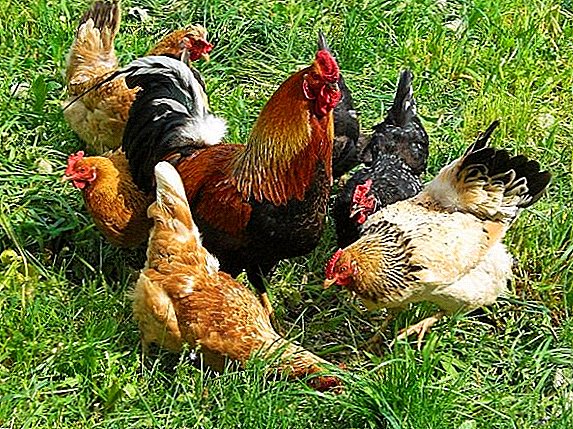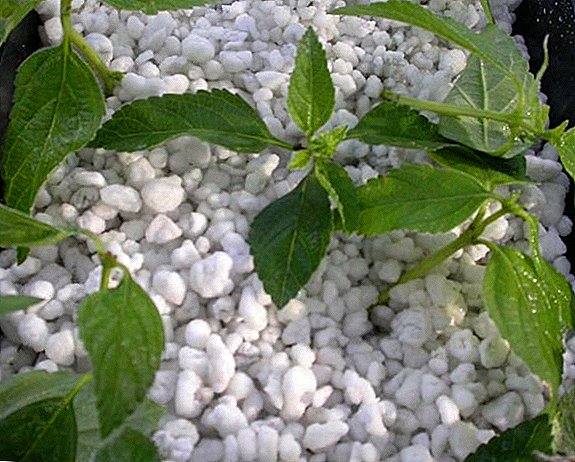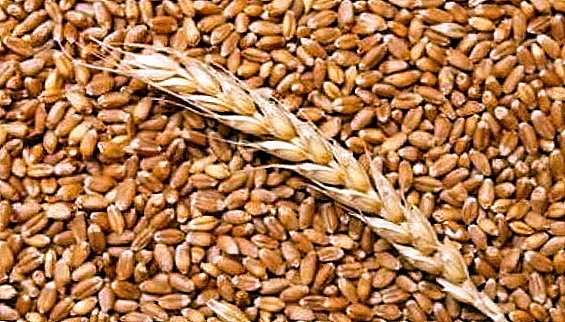 Rabbit cage can be easily built at home from scrap materials. But it is important to take into account the shape of the structure and its safety for the fluffy residents. It is from these factors that the success of the rabbit breeding depends. Which ideally should be an abode for the eared, from which it is better to build it and how to do it correctly - you will learn about it further from the article.
Rabbit cage can be easily built at home from scrap materials. But it is important to take into account the shape of the structure and its safety for the fluffy residents. It is from these factors that the success of the rabbit breeding depends. Which ideally should be an abode for the eared, from which it is better to build it and how to do it correctly - you will learn about it further from the article.
What should be a rabbit dwelling
The development of poddermatitis and frequent injuries of the limbs in rabbits are the first signals of their improper content. In the future, such conditions are not the best impact on the performance of the wards and their safety. Therefore, the breeder, in addition to the front of feeding and watering, as well as the density of animal planting, should pay close attention to the characteristics of rabbit housing.
Unfortunately, not everybody can create decent conditions for the eared animal. We recommend that you familiarize yourself with the main secrets of successful rabbit breeding.
Ideally, cages for eared pets should be a reliable shelter from the weather and at the same time well ventilated and also illuminated. Constant control over the level of exposure to external factors is important, which largely depends on weather conditions, season and time of day.  It is unacceptable that animal feces are collected inside. Many breeders solve this problem by installing a slatted floor. But, according to experts, it is in the mesh cells that the highest degree of injury is recorded. Therefore, such designs are extremely undesirable for rabbits.
It is unacceptable that animal feces are collected inside. Many breeders solve this problem by installing a slatted floor. But, according to experts, it is in the mesh cells that the highest degree of injury is recorded. Therefore, such designs are extremely undesirable for rabbits.
These animals are very sensitive to air exchange and dampness. Excess ammonia and hydrogen sulfide have a bad effect on their productivity. Therefore, the humidity indicators in the rabbit house must comply with 60-70 %.
Important! For rabbits, fine spinous straw or hay is not recommended as bedding. Preferred soft awnless cereals. They are used from late autumn until spring. At other times of the year, covering the floor is necessary only in cages with pregnant females. And then do it for 5 days before okrol.
Their abode should be inaccessible to rodents and predators. You can build it from used boards, plywood, bricks, cutting, slate. For mass breeding of long-eared group multi-tier constructions are perfect. On them, as well as on the simplest cells, it is recommended to provide a single or gable roof.  Experienced breeders advise:
Experienced breeders advise:
- Choose to place rabbit cages dry and elevated areas, away from sources of moisture and water, but in the shade of trees. This is due to intolerance to eared direct sunlight.
- Strictly monitor the ventilation design and prevent the slightest drafts. In the houses of the wards air movement is undesirable, which exceeds the speed of 30 m / s.
- For the winter, insulate the cells so that the temperature of the animals is within the range of + 10 ... +20 ° C.
- Ensure that in the winter time, the closed rabbit fairs are lit at least 10 hours a day. Ideally, a window installed on the entire wall on the east side of the structure can solve this problem.
- Installing cells at a height of 80-100 cm from the ground. It is necessary to protect the wards from rats, and this solution will greatly facilitate maintenance.
Did you know? In Australia, the breeding of rabbits is prohibited by law, the violation of which is fraught with a fine of 30 thousand dollars. This is due to the fact that local people consider wild animals as the most destructive pests. Every year, they destroy agricultural crops and their rapid activity leads to the degradation of whole lands, causing damage to the population in excess of $ 600 million.
How to make a house for the rabbit do it yourself
Regardless of what type of cage you prefer, and how many individuals it will be designed for, its basis consists of: the frame, walls, floor, ceiling and doors. But before taking up the tool, you need to thoroughly understand the necessary dimensions of the structure and make its drawings.
Design and dimensioning
The classic version of the rabbit queen cell has dimensions of 70 x 100 x 60 cm. For young stock, the construction can be done according to the same parameters, shortened by 30 cm in length.
It is important for the builder to understand that the entire area of the structure for the rabbit and her offspring will be further divided into a walking compartment and a deaf zakut. The first zone in most cases is a square with sides of 50 cm.
And the second is a deaf box with a length of 25 cm and a width of 50 cm. A removable door is fastened on the front side of the building, and a small manhole at a height of 15 cm is provided on the wall adjacent to the walking space.
Learn how to build an open-air cage and rabbit cage, how to make cages using the Zolotukhin method, as well as a shed for rabbits with your own hands.
Under the floor, be sure to provide a pan to collect feces. The floor can be made of densely set wide slats. In cases of use of gratings, to avoid injury, be sure to cover them with a rug, leaving small gaps around the perimeter.  Experienced breeders advise to calculate the height of the rabbit cage on the front side of 55 cm, and on the rear side - 30 cm. A slope on the roof can serve as a pallet, if placed at the top of the second tier. For reliability it will need to be galvanized.
Experienced breeders advise to calculate the height of the rabbit cage on the front side of 55 cm, and on the rear side - 30 cm. A slope on the roof can serve as a pallet, if placed at the top of the second tier. For reliability it will need to be galvanized.
Did you know? Rabbits chew 120 times a minute and have more than 17 thousand taste buds.If you are planning to build a two-piece house for adult rabbits, count for it a length of 140-210 cm, width 60-70 cm and height 50-70 cm. The sections will be separated by a V-shaped grass and hay feeder. On the front side, provide 2 solid doors each in the nested compartments and 2 mesh doors each in the walking areas.
Remember that cell sizes are largely dependent on the breed of the wards and the way they are maintained. For example:
- little rabbits about 0.5 required-0.7 square meters;
- adult males - 0.17 m2;
- young stock - 0, 12 m2.

Materials and tools for work
You can build an abode for eared pets from any material that is in your household. But, according to experts, among all the available diversity, the tree has best recommended itself. It is environmentally friendly, durable and retains heat well, does not heat in the heat.
Did you know? The left rabbit's foot in many cultures of the world, including Europe, North and South America, Africa and China, is revered as a talisman of good luck and happiness. It is likely that belief in the magical power of eared legs originated in European countries from 600 BC among the Celtic peoples.
Strongly not suitable for such structures metal. In winter, animals in such a house can freeze, and in summer - overheat. Also avoid using chipboard. This material quickly absorbs moisture, resulting in severe crumbles.  Here is a list of necessary tools and materials for further work:
Here is a list of necessary tools and materials for further work:
- 10 wooden bars 3 m long, 30 x 50 mm (for the frame);
- boards or plywood sheets measuring 1.5 by 1.5 m, 10 mm thick (for wall cladding);
- meter piece of slate (for the roof);
- wooden slats 3 cm wide or welded mesh with cells 15 x 15 mm (for the floor);
- metal sheet 1 m long (for the construction of a pallet);
- 4 sheds (for fastening 2 doors);
- boards (for a deaf door);
- welded mesh with cells 2.5 x 2.5 cm (for the ventilation door in the free-standing area);
- metal rods (for V-shaped hay feeder);
- electric drill;
- hammer;
- saw for wood;
- roulette;
- pliers;
- construction stapler;
- gon;
- marking pencil;
- sandpaper coarse fraction;
- 1 kg of self-tapping screws 30 and 70 mm, nails.

Step-by-step instruction
When everything you need is available, you can start work:
- Cut the measured length of the boards. On a flat surface of the prepared blanks, scrape the frame of the structure. In the case of a multi-tiered structure, be sure to provide after each tier a space of up to 15 cm for the installation of a pallet.
- The front and rear bars connect the transverse slats. This is the basis for the cell.
- Measure from the harvested wooden bars 4 legs to the rabbit house. Prick them to the resulting wooden rectangle so that the height remains a margin of 30-40 cm to the floor.
- Measure the slats for the door and screw them together with screws. Then beat the resulting frame mesh. Fasteners are made with a construction stapler from the inside.
- Measure the desired length of the boards and cut the workpiece. Collapse them to the skeleton of the cell.
- Hang the hinges on the hinges and provide a latch on it. Convenient when the design opens from top to bottom.
- Inside the center of the cage, attach a V-shaped sennik, dividing the space into 2 sections.
- Now you can start the construction of a deaf pen. Many breeders build it with a removable plywood bottom to prevent increased damp inside the cage. Therefore, this part of the house must be completely made of boards or plywood.
- Between the nesting and walking areas, install a plywood partition with a hole for the passage of residents.
- After that, make a solid door in the dead part of the cage, also attaching it to the hinges. Do not forget to attach a latch to it.
- Mount the roof of the boards or slate. It is desirable that it was folding. Therefore, experienced owners are advised to use hinged hinges as fasteners.
- Now lay the floor on the bottom of the rack structure, leaving 1.5 cm gaps between them. If you retreat more, animals can get stuck in the gaps and injure their paws. Alternatively, a grid with small cells is suitable, but then you will need to provide a mat.
- From a metal sheet, build a low pallet of appropriate size and place it under the cage. Some breeders are advised to place this item at an angle to make it easier to clean.
Home Improvement Inside
After checking the security of the finished cage, you can proceed to its arrangement. First of all, pay attention to the floor. From the net coatings rabbits often suffer from poddermatit. Therefore, if your design is made of metal bars, be sure to cover it with a rug.
When arranging rabbitry one of the main stages is the creation of the bottom of the house. Read about what floor to choose for rabbits in a cage and how to make it.
It is categorically not suitable for this product made of carpet, wool, as they often cause malfunctions of the gastrointestinal tract of the animal. Do not forget for a moment that we are talking about a rodent who can try everything on a tooth that is within its reach.
After that, lay a thick layer of bedding on the floor. In the autumn-spring period, it is important for rabbits that their paws are protected from pressure sores. For this purpose, sawdust, coarse straw, or hay of soft awnless cereals are ideally suited. Particularly attentive to the choice of material should be when the content of downy breeds.  Caught in their coat awnings cause discomfort and pain. Straw is preferable because it keeps you warm and safe for eared ones. Remember that the larger the pet, the more litter it needs. For adults it is enough to lay a layer thickness of 12.5 -15.5 cm
Caught in their coat awnings cause discomfort and pain. Straw is preferable because it keeps you warm and safe for eared ones. Remember that the larger the pet, the more litter it needs. For adults it is enough to lay a layer thickness of 12.5 -15.5 cm
In addition to the already provided suzelek for hay and grass, in the cage of an animal you need to put a water bottle and a feeder. It is important that these containers cannot be overturned or clogged with excrement. Therefore, experienced breeders advise to get a purchased drinker, which from the inside is attached to the front side of the cage. A feeder can be built independently.
Familiarize yourself with step-by-step instructions for making troughs and drinking bowls for rabbits with your own hands.
To do this, in the cage, vertically attach a wooden bar and attach to it a wooden rectangle 7 cm high and 30 cm wide. On top, at a distance of 20 cm, hammer the guide bar.
And after that, sew the structure with plywood, so that the skin to the top fits between the guide rails, and at the bottom rests against the feeder, but does not block access to the feed. As a result, you can fill the building through the top. 
House care
Rabbits are very sensitive to purity in their abode. This factor largely determines the health of pets. Therefore, the breeder regularly needs to:
- remove manure from the pallet (ammonia fumes are very bad for the eared health);
- daily change the litter in the cage (otherwise, the animal will fall ill due to increased dampness);
- before each feeding, clean the feeders from food residues (rabbits are distinguished by increased sensitivity of the gastrointestinal tract);
- every day to change the water in the drinkers;
- each semester conduct a general cleaning in a rabbit house with its complete disinfection.
Did you know? A two-kilogram rabbit can drink as much water as a ten-kilogram dog.
Getting rid of pathogenic microflora in rabbit cages is not so easy. Therefore, you cannot start this process. The rabbit breeder must understand that the infection and viruses possess extraordinary survivability, infecting each new generation of animals that are bred under these conditions. Consequently, it is by timely disinfecting the cages and the entire inventory to prevent the livestock from falling.  Disinfection of cells and the entire inventory. Since microbes living in the eared monastery are very resistant to high and low temperatures, they quickly become accustomed to toxic chemicals, they can only be destroyed by special disinfection methods. All planes (both internal and external) of the rabbitry, all inventory involved in the care, as well as the walls, floor and ceiling of the room in which the cage is located should be treated.
Disinfection of cells and the entire inventory. Since microbes living in the eared monastery are very resistant to high and low temperatures, they quickly become accustomed to toxic chemicals, they can only be destroyed by special disinfection methods. All planes (both internal and external) of the rabbitry, all inventory involved in the care, as well as the walls, floor and ceiling of the room in which the cage is located should be treated.
Did you know? The eyes of rabbits are arranged in such a way that, without turning around, they can observe what is happening behind them.
First, rabbits are transplanted from the construction, and only after that they clear the space of faeces, bedding and dirt. Then remove all removable elements and with a hose with a jet of hot water wash the cage from the inside. Repeat this procedure with any detergent and brush. The same is done with inventory, feeders and drinkers.
After the done manipulations, the rabbit housing is left to dry and only then it is treated with disinfectants: Virocid, Ash liquor, Ecocide C, Formalin, Glutex, Virosan, Whiteness, Virkon C, formaldehyde solution, soda ash or Bromosept-50.  Now it is possible to return all the objects removed from the cage and place the pets in them. Nothing threatens their health.
Now it is possible to return all the objects removed from the cage and place the pets in them. Nothing threatens their health.
Rabbit breeders should consider the instructions for use of the Virotz decontamination agent.
As you can see, at home from scrap materials you can independently build a rabbit of the right size for a certain number of animals. The most difficult in this process is the calculation of dimensions and preparation of drawings. We hope our article will help you to solve these nuances and quickly complete the construction started.












